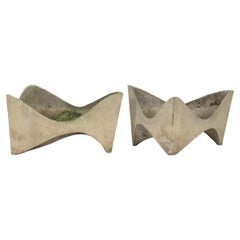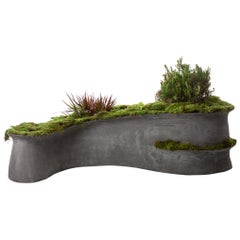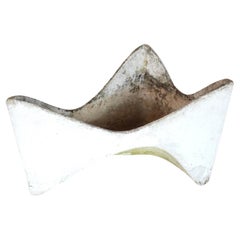Willy Guhl Molar
Vintage 1960s Swiss Mid-Century Modern Planters and Jardinieres
Concrete
People Also Browsed
2010s French Modern Chairs
Oak
21st Century and Contemporary Modern Planters and Jardinieres
Cement
Vintage 1960s American Planters and Jardinieres
Cement
2010s Austrian Jugendstil Chandeliers and Pendants
Silk
Vintage 1960s Swiss Planters and Jardinieres
Concrete
2010s American Modern Coffee and Cocktail Tables
Wood, Fir, Reclaimed Wood
Vintage 1960s Swiss Planters and Jardinieres
Cement
Vintage 1960s Swiss Planters and Jardinieres
Concrete
21st Century and Contemporary Modern Planters and Jardinieres
Cement
Mid-20th Century Swiss Mid-Century Modern Planters and Jardinieres
Cement
Vintage 1960s Swiss Planters and Jardinieres
Cement
Vintage 1950s Swiss Modern Planters and Jardinieres
Concrete
Vintage 1970s Swiss Mid-Century Modern Planters and Jardinieres
Cement
Mid-20th Century Swiss Mid-Century Modern Planters, Cachepots and Jardin...
Cement
21st Century and Contemporary American Aesthetic Movement Planters and J...
Concrete, Cement
Mid-20th Century Swiss Mid-Century Modern Planters and Jardinieres
Concrete
Recent Sales
Vintage 1960s Swiss Mid-Century Modern Planters and Jardinieres
Cement
Willy Guhl for sale on 1stDibs
Decades prior to the mass popularity of neo-industrial cement floors and furniture taking shape, there was Willy Guhl. The Swiss creative is considered one of the first “industrial” designers in his home country. He pioneered a rugged, organic style of modern furniture and decor — stylish planters, shapely seating and lots more — that remains widely coveted by many today.
Guhl was born in 1915 in Stein am Rhein and worked as a carpenter before beginning studies at the Zurich School of Applied Arts (known today as the Zurich University of the Arts), where he would go on to teach for nearly 40 years.
While Guhl is well-known for his range of provocative garden elements as well as his patio and outdoor furniture, today’s legion of mid-century modern enthusiasts are likely familiar with the designer’s iconic Loop chair (introduced in 1954). For this sculptural seat and other furnishings, Guhl tended toward industrial materials, which he bent and shaped into organic forms for a striking juxtaposition. Much of his work is crafted from either concrete or Eternit, a mixture of cement and asbestos developed by the Belgian company Etex, which, in the 1950s, commissioned Guhl and his students at the School of Applied Arts to conceive planters in the material. The resulting vessels — some hourglass-shaped, some in the form of handkerchiefs, all suitable for indoors or exteriors — remain some of Guhl’s most collectible pieces.
Guhl’s affiliation with the Swiss “neo-functional” movement centered on the idea of simplifying design without sacrificing form. According to Guhl, his mission was “achieving the most with the minimum of effort.”
In addition to his work as a designer, Guhl left his mark on subsequent creatives through his 39-year tenure at his alma mater, where he was instructor to the likes of Robert Haussmann, Kurt Thut and Bruno Rey. Modern-day shoppers at IKEA owe Guhl a debt of gratitude too. He was an early advocate of flat-pack furniture, championing its ability to make good design more widely accessible.
At its core, though, Guhl’s work was inherently human-centric: “At the center of my efforts, I put people and their living requirements,” he once said. “My products must be useful to people.” Guhl died in 2004 at the age of 89.
Find a range of vintage Willy Guhl furniture and decorative objects on 1stDibs.
A Close Look at Mid-Century Modern Furniture
Organically shaped, clean-lined and elegantly simple are three terms that well describe vintage mid-century modern furniture. The style, which emerged primarily in the years following World War II, is characterized by pieces that were conceived and made in an energetic, optimistic spirit by creators who believed that good design was an essential part of good living.
ORIGINS OF MID-CENTURY MODERN FURNITURE DESIGN
- Emerged during the mid-20th century
- Informed by European modernism, Bauhaus, International style, Scandinavian modernism and Frank Lloyd Wright’s architecture
- A heyday of innovation in postwar America
- Experimentation with new ideas, new materials and new forms flourished in Scandinavia, Italy, the former Czechoslovakia and elsewhere in Europe
CHARACTERISTICS OF MID-CENTURY MODERN FURNITURE DESIGN
- Simplicity, organic forms, clean lines
- A blend of neutral and bold Pop art colors
- Use of natural and man-made materials — alluring woods such as teak, rosewood and oak; steel, fiberglass and molded plywood
- Light-filled spaces with colorful upholstery
- Glass walls and an emphasis on the outdoors
- Promotion of functionality
MID-CENTURY MODERN FURNITURE DESIGNERS TO KNOW
- Charles and Ray Eames
- Eero Saarinen
- Milo Baughman
- Florence Knoll
- Harry Bertoia
- Isamu Noguchi
- George Nelson
- Danish modernists Hans Wegner and Arne Jacobsen, whose emphasis on natural materials and craftsmanship influenced American designers and vice versa
ICONIC MID-CENTURY MODERN FURNITURE DESIGNS
- Eames lounge chair
- Nelson daybed
- Florence Knoll sofa
- Egg chair
- Womb chair
- Noguchi coffee table
- Barcelona chair
VINTAGE MID-CENTURY MODERN FURNITURE ON 1STDIBS
The mid-century modern era saw leagues of postwar American architects and designers animated by new ideas and new technology. The lean, functionalist International-style architecture of Le Corbusier and Bauhaus eminences Ludwig Mies van der Rohe and Walter Gropius had been promoted in the United States during the 1930s by Philip Johnson and others. New building techniques, such as “post-and-beam” construction, allowed the International-style schemes to be realized on a small scale in open-plan houses with long walls of glass.
Materials developed for wartime use became available for domestic goods and were incorporated into mid-century modern furniture designs. Charles and Ray Eames and Eero Saarinen, who had experimented extensively with molded plywood, eagerly embraced fiberglass for pieces such as the La Chaise and the Womb chair, respectively.
Architect, writer and designer George Nelson created with his team shades for the Bubble lamp using a new translucent polymer skin and, as design director at Herman Miller, recruited the Eameses, Alexander Girard and others for projects at the legendary Michigan furniture manufacturer.
Harry Bertoia and Isamu Noguchi devised chairs and tables built of wire mesh and wire struts. Materials were repurposed too: The Danish-born designer Jens Risom created a line of chairs using surplus parachute straps for webbed seats and backrests.
The Risom lounge chair was among the first pieces of furniture commissioned and produced by legendary manufacturer Knoll, a chief influencer in the rise of modern design in the United States, thanks to the work of Florence Knoll, the pioneering architect and designer who made the firm a leader in its field. The seating that Knoll created for office spaces — as well as pieces designed by Florence initially for commercial clients — soon became desirable for the home.
As the demand for casual, uncluttered furnishings grew, more mid-century furniture designers caught the spirit.
Classically oriented creators such as Edward Wormley, house designer for Dunbar Inc., offered such pieces as the sinuous Listen to Me chaise; the British expatriate T.H. Robsjohn-Gibbings switched gears, creating items such as the tiered, biomorphic Mesa table. There were Young Turks such as Paul McCobb, who designed holistic groups of sleek, blond wood furniture, and Milo Baughman, who espoused a West Coast aesthetic in minimalist teak dining tables and lushly upholstered chairs and sofas with angular steel frames.
As the collection of vintage mid-century modern chairs, dressers, coffee tables and other furniture for the living room, dining room, bedroom and elsewhere on 1stDibs demonstrates, this period saw one of the most delightful and dramatic flowerings of creativity in design history.
Finding the Right planters-jardinieres for You
Beautiful plants deserve beautiful homes. It’s time to introduce antique and vintage planters and jardinieres to your home’s interiors and outdoor garden area.
The word “jardiniere” has roots in French, but the appeal of these vessels is global. The popularity of jardinieres — ceramic pots intended for cut flowers or plants — quickly gained traction in the United States during the start of the 20th century, when you could find them in some middle- and upper-class American homes. Jardinieres had already been coveted goods overseas for at least a couple of centuries by then, as intricate planters crafted from Chinese porcelain or gilded-bronze versions from Japan could be found in the living rooms of wealthy Europeans.
Today, the love for planters and jardinieres knows no bounds. And whether you consider yourself a proper gardener or merely a doting plant parent, there is likely a use for a planter inside or in the lively outdoor space around your home.
Outside, a pair of marble and terracotta planters or cast-iron urns designed in the neoclassical style can add a stately touch to your landscape design while helping establish boundaries between the areas you’ve created for gardening and entertaining.
Bare corners in your living room or dining room can often be difficult to populate with furnishings that fit just so, and a planter can change that. While it’s possible to get maximal impact from minimalist pottery — an understated mid-century modern planter could deliver on that front — you might be pining for an on-trend planter with pizzazz. Look to an outwardly angular fiberglass design decked out in bright colors to give your blooms a run for their money, while mounted or vintage hanging vessels can serve as the frame for nature’s organic artwork, quite literally taking your gardening skills to the next level.
Browse a broad collection of antique and vintage planters and jardinieres on 1stDibs today.



